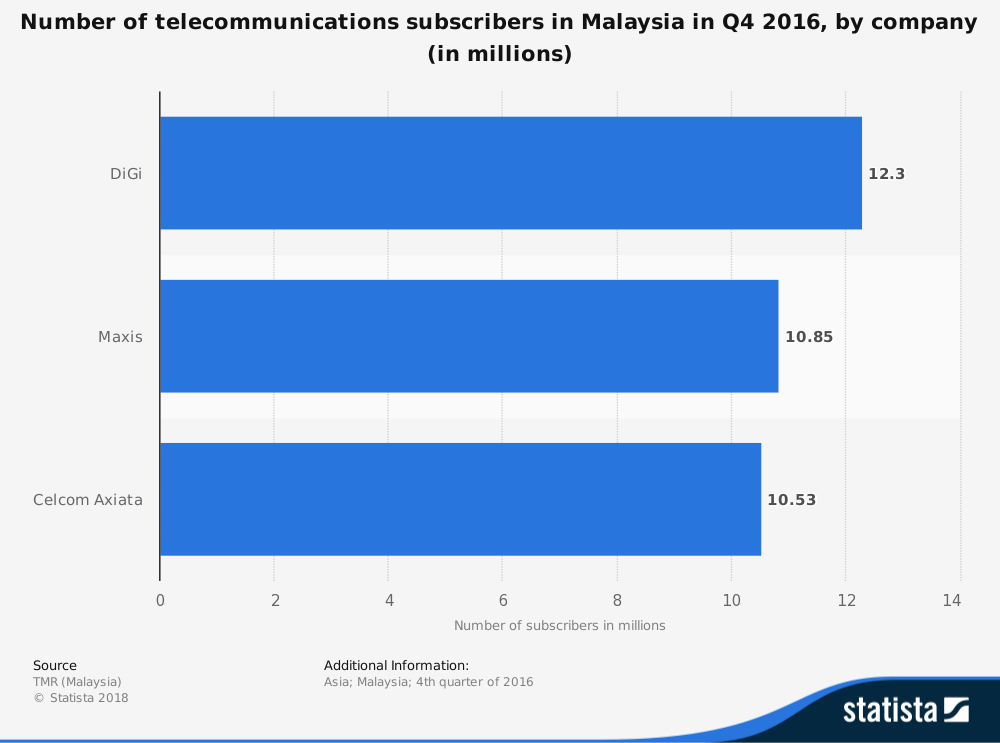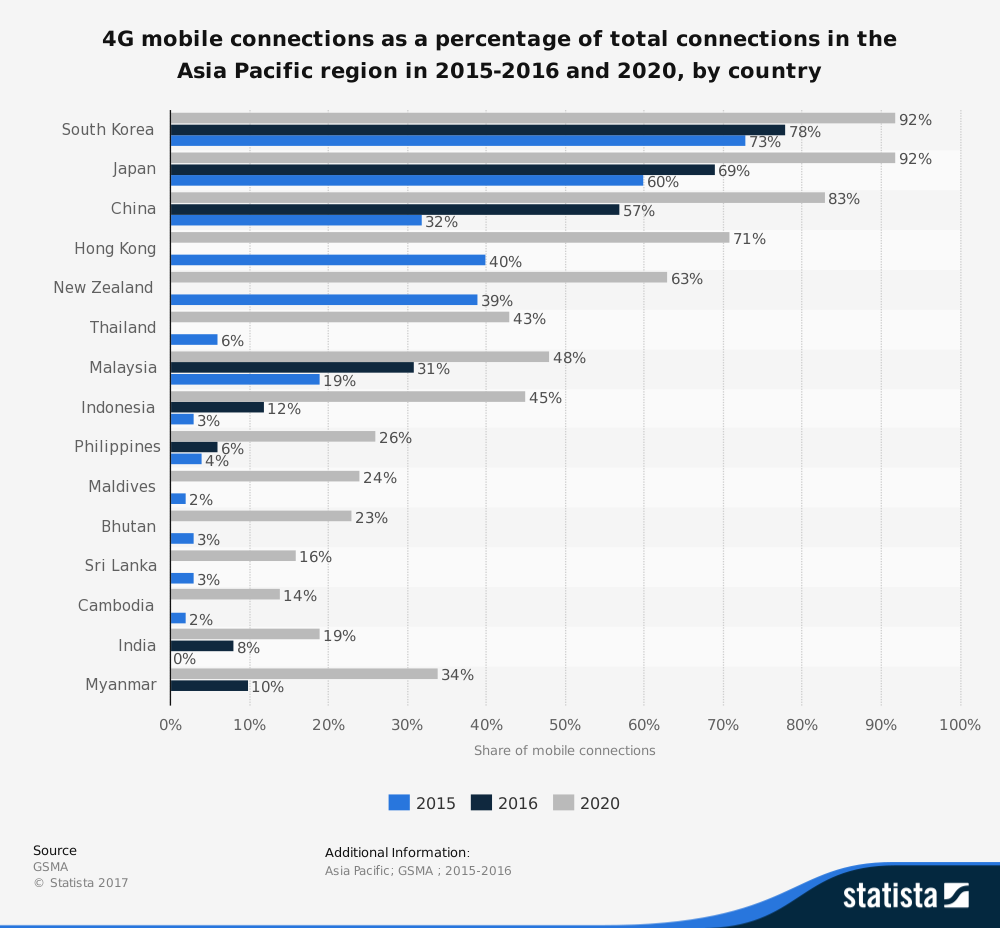In Malaysia, telecommunication providers offer the basic services and features that help people speak with one another and consume various types of content. Most of the services that are provided are based on 2G wireless technology, with expansion into 3G and 4G technologies on a path that is similar to what was seen in the United States.
Pricing for the industry is set by the Ministry of Communication in Malaysia. Although carriers are free to set their own prices, there is maximum ceiling which is allowed. This has caused innovative packaging to be created to entice customers to a specific service since all providers provide the same basic essentials.
There have been particularly high levels of growth in specific sectors within the Malaysia telecommunication industry since 2010, most notably in broadband connections. Although pricing is somewhat higher in Malaysian than other nations in the same region, the signal coverage and overall connection strength tends to be more reliable.
Interesting Malaysia Telecommunication Industry Statistics
#1. About 32% of the population has access to mobile phones or a mobile network within the country as of 2016. (Malaysian Communications and Multimedia Commission)
#2. About one-third of consumers take advantage of mobile number portability in Malaysia. (Malaysian Communications and Multimedia Commission)

#3. The broadband penetration rate in Malaysia is currently 18%. About 23% of households have access to a computer that is capable of handling a broadband connection. There are currently about 31 million broadband subscriptions that are currently active. (Malaysian Communications and Multimedia Commission)
#4. There are currently about 24 fixed broadband subscriptions available in the industry for every 100 inhabitants. (Malaysian Communications and Multimedia Commission)
#5. The fixed telephone subscription and penetration rate within Malaysia currently stands at 42%. When direct exchange lines are included with this figure, it rises to 45%. There are about 4.5 million fixed telephone subscriptions that are currently active. (Malaysian Communications and Multimedia Commission)
#6. The average person in Malaysia consumes about 52 minutes of broadcast television every day. About 55% of households in the country are believed to have television accesses. (Malaysian Communications and Multimedia Commission)
#7. The current pay TV subscription rate has a 55% penetration for the Malaysian telecommunication industry. (Malaysian Communications and Multimedia Commission)
#8. About 56% of households have access to a recording device, including a VCR or DVD player. (Malaysian Communications and Multimedia Commission)
#9. About 53% of homes that have a television in Malaysia also have a pay TV subscription that the manage monthly. (Malaysian Communications and Multimedia Commission)
#10. There are an estimated 28.5 million mobile broadband subscriptions that are currently active within the Malaysia telecommunication industry. (Malaysian Communications and Multimedia Commission)

#11. When both fixed and mobile broadband connections or subscriptions are evaluated, the total broadband penetration rate for the industry is 81.5%. (Malaysian Communications and Multimedia Commission)
#12. Since 2011, the total number of broadband subscriptions has grown at an average growth rate of 32.6% each year. Since 2016, the Malaysian telecommunication industry has stopped reporting on subscriptions that are less than 1mbit/s. (Malaysian Communications and Multimedia Commission)
#13. Household broadband subscriptions have risen at an annual rate of 11.6% since 2015, with the largest gains seen in the postpaid mobile segment. (Malaysian Communications and Multimedia Commission)
#14. With a continued emphasis on copper to fiber migration for broadband, high-speed broadband connections have grown at rates as high as 245% from the year before. (Malaysian Communications and Multimedia Commission)
#15. About 90% of consumers in Malaysia use a smartphone to access the internet on a regular basis. Since 2014, the rates of smartphone ownership within the population have risen from 74.3% to 90.7%. (Malaysian Communications and Multimedia Commission)
#16. In 2016, about 92% of the population had 3G data coverage in Malaysia and about 64% of people had 4G coverage access. (Malaysian Communications and Multimedia Commission)
#17. Prepaid segments are the largest share of broadband subscriptions within the industry. In 2016, they accounted for over 43% of the total market share. In 2015, they accounted for less than 30% of the market share. (Malaysian Communications and Multimedia Commission)
#18. Five states in Malaysia reported higher broadband penetration rates in year-to-year data in 2016, despite having penetration rates that were below the national average. Those states were Sarawak, Melaka, Perak, Putrajaya, and Negeri Sembilan. (Malaysian Communications and Multimedia Commission)
#19. In 2016, there were 8 states in Malaysia that actually saw drops in their broadband penetration rates. This was due to a drop in pay-per-use subscriptions. (Malaysian Communications and Multimedia Commission)
#20. Through the year 2021, the industry expects to see fixed broadband growth rates of 3% each year. High-speed broadband expansion is expected to be 9% annually, thanks to government marketing and subsidies within the telecommunications industry. (Malaysian Communications and Multimedia Commission)

#21. Both the prepaid and the postpaid market segments are forecast to grow at 2% each year through 2021. (Malaysian Communications and Multimedia Commission)
#22. Under the 11th Malaysia Plan, the goal of the government is to increase the industry contribution to the GDP to 17%. It currently stands at 13.1%. (U.S. International Trade Administration)
#23. Since 2011, the datacenter industry has grown to support a total of 26 companies. In total there are more than 200 specialized service providers that are capable of providing consumers with storage, retrieval, high-speed remote access, and additional services that may be desired or required. (U.S. International Trade Administration)
#24. The total number of telecommunication exports has reduced in value by more than $6 billion since 2014. At the same time, Malaysian imports from the U.S. have decreased from $5.8 billion to $5.1 billion. (U.S. International Trade Administration)
#25. The sectors of the industry that are poised for the largest levels of future growth include cloud services, cyber security, software development, digital content, and big-data analytics. (U.S. International Trade Administration)
Malaysia Telecommunication Industry Trends and Analysis
The Malaysia telecommunication industry is continuing to grow. Demand levels are high for good connections. Many of the investments are sponsored by the government, creating unique work opportunities that are changing how people live and work within the country.
There have been reductions in coverage areas due to provider consolidation. Malaysia is also transitioning to a high-speed telecommunications infrastructure, which is not anticipated to be complete until 2021. The true potential of this industry may not be known until then.
Much of the urban areas, such as Johor, Selangor, and Kuala Lumpur, have modernized their telecommunication networks already. That has placed an emphasis on rural upgrades, which has led to a steady migration of qualified workers to the suburbs or outskirts of the major metropolitan centers.
With good signal coverage, strong carrier rivalries, and a desire to be competitive on a global stage, the Malaysia telecommunication industry looks to have a strong and exciting future.
Although millions of people visit Brandon's blog each month, his path to success was not easy. Go here to read his incredible story, "From Disabled and $500k in Debt to a Pro Blogger with 5 Million Monthly Visitors." If you want to send Brandon a quick message, then visit his contact page here.
